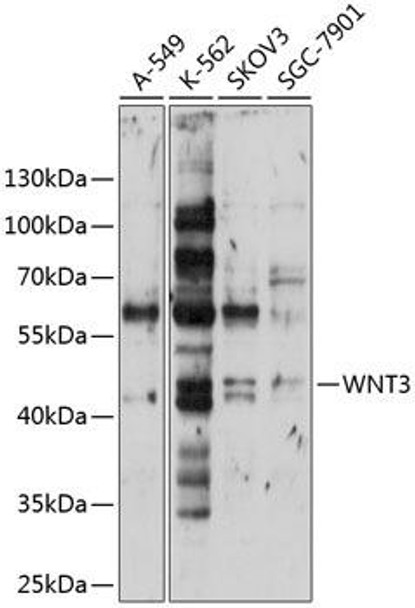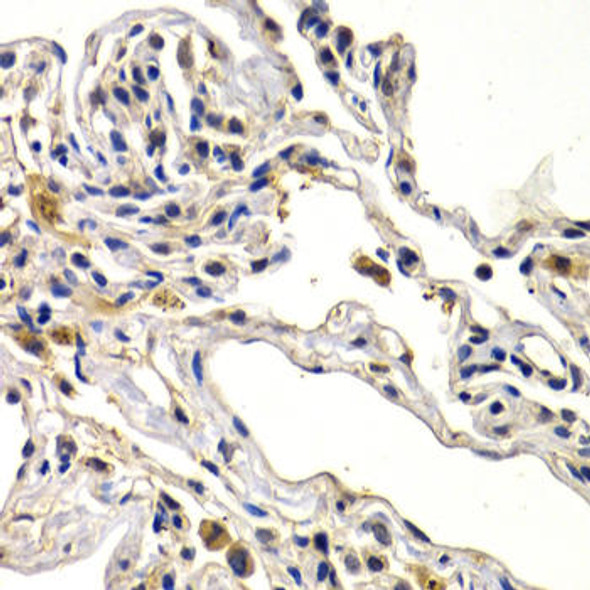Anti-WNT3 Antibody (CAB9328)
- SKU:
- CAB9328
- Product type:
- Antibody
- Application:
- WB
- Reactivity:
- Human
- Host Species:
- Rabbit
- Isotype:
- IgG
- Research Area:
- Metabolism
Description
| Antibody Name: | Anti-WNT3 Antibody |
| Antibody SKU: | CAB9328 |
| Antibody Size: | 20uL, 50uL, 100uL |
| Application: | WB |
| Reactivity: | Human |
| Host Species: | Rabbit |
| Immunogen: | Recombinant fusion protein containing a sequence corresponding to amino acids 166-355 of human WNT3 (NP_110380.1). |
| Application: | WB |
| Recommended Dilution: | WB 1:200 - 1:2000 |
| Reactivity: | Human |
| Positive Samples: | A-549, K-562, SKOV3, SGC-7901 |
| Immunogen: | Recombinant fusion protein containing a sequence corresponding to amino acids 166-355 of human WNT3 (NP_110380.1). |
| Purification Method: | Affinity purification |
| Storage Buffer: | Store at -20°C. Avoid freeze / thaw cycles. Buffer: PBS with 0.02% sodium azide, 50% glycerol, pH7.3. |
| Isotype: | IgG |
| Sequence: | VLVS REFA DARE NRPD ARSA MNKH NNEA GRTT ILDH MHLK CKCH GLSG SCEV KTCW WAQP DFRA IGDF LKDK YDSA SEMV VEKH RESR GWVE TLRA KYSL FKPP TERD LVYY ENSP NFCE PNPE TGSF GTRD RTCN VTSH GIDG CDLL CCGR GHNT RTEK RKEK CHCI FHWC CYVS CQEC IRIY DVHT CK |
| Gene ID: | 7473 |
| Uniprot: | P56703 |
| Cellular Location: | Secreted, extracellular matrix, extracellular space |
| Calculated MW: | 39kDa |
| Observed MW: | 45kDa |
| Synonyms: | WNT3, INT4, TETAMS |
| Background: | The WNT gene family consists of structurally related genes which encode secreted signaling proteins. These proteins have been implicated in oncogenesis and in several developmental processes, including regulation of cell fate and patterning during embryogenesis. This gene is a member of the WNT gene family. It encodes a protein which shows 98% amino acid identity to mouse Wnt3 protein, and 84% to human WNT3A protein, another WNT gene product. The mouse studies show the requirement of Wnt3 in primary axis formation in the mouse. Studies of the gene expression suggest that this gene may play a key role in some cases of human breast, rectal, lung, and gastric cancer through activation of the WNT-beta-catenin-TCF signaling pathway. This gene is clustered with WNT15, another family member, in the chromosome 17q21 region. |
| UniProt Protein Function: | WNT3: Ligand for members of the frizzled family of seven transmembrane receptors. Wnt-3 and Wnt-3a play distinct roles in cell-cell signaling during morphogenesis of the developing neural tube. Defects in WNT3 are the cause of autosomal recessive tetra-amelia (ARTTRA). Tetra-amelia is a rare human genetic disorder characterized by complete absence of all four limbs and other anomalies such as craniofacial, nervous system, pulmonary, skeletal and urogenital defects. Belongs to the Wnt family. |
| UniProt Protein Details: | Protein type:Secreted; Oncoprotein; Secreted, signal peptide Chromosomal Location of Human Ortholog: 17q21 Cellular Component: extracellular space; proteinaceous extracellular matrix; Golgi lumen; endoplasmic reticulum lumen; extracellular region; plasma membrane Molecular Function:protein domain specific binding; protein binding; frizzled binding; receptor agonist activity Biological Process: embryonic forelimb morphogenesis; axon guidance; cell fate commitment; cell morphogenesis; dorsal/ventral axis specification; Wnt receptor signaling pathway through beta-catenin; positive regulation of collateral sprouting in the absence of injury; negative regulation of axon extension involved in axon guidance; embryonic hindlimb morphogenesis; Spemann organizer formation at the anterior end of the primitive streak; neuron differentiation; limb bud formation; mesoderm formation; gamete generation; anterior/posterior axis specification Disease: Tetraamelia, Autosomal Recessive |
| NCBI Summary: | The WNT gene family consists of structurally related genes which encode secreted signaling proteins. These proteins have been implicated in oncogenesis and in several developmental processes, including regulation of cell fate and patterning during embryogenesis. This gene is a member of the WNT gene family. It encodes a protein which shows 98% amino acid identity to mouse Wnt3 protein, and 84% to human WNT3A protein, another WNT gene product. The mouse studies show the requirement of Wnt3 in primary axis formation in the mouse. Studies of the gene expression suggest that this gene may play a key role in some cases of human breast, rectal, lung, and gastric cancer through activation of the WNT-beta-catenin-TCF signaling pathway. This gene is clustered with WNT15, another family member, in the chromosome 17q21 region. [provided by RefSeq, Jul 2008] |
| UniProt Code: | P56703 |
| NCBI GenInfo Identifier: | 13540477 |
| NCBI Gene ID: | 7473 |
| NCBI Accession: | NP_110380.1 |
| UniProt Secondary Accession: | P56703,Q2M237, Q9H1J9, |
| UniProt Related Accession: | P56703 |
| Molecular Weight: | 39,645 Da |
| NCBI Full Name: | proto-oncogene Wnt-3 |
| NCBI Synonym Full Names: | Wnt family member 3 |
| NCBI Official Symbol: | WNT3 |
| NCBI Official Synonym Symbols: | INT4; TETAMS |
| NCBI Protein Information: | proto-oncogene Wnt-3 |
| UniProt Protein Name: | Proto-oncogene Wnt-3 |
| UniProt Synonym Protein Names: | Proto-oncogene Int-4 homolog |
| Protein Family: | Proto-oncogene |
| UniProt Gene Name: | WNT3 |
| UniProt Entry Name: | WNT3_HUMAN |







